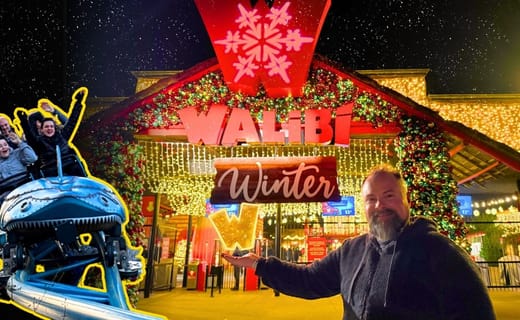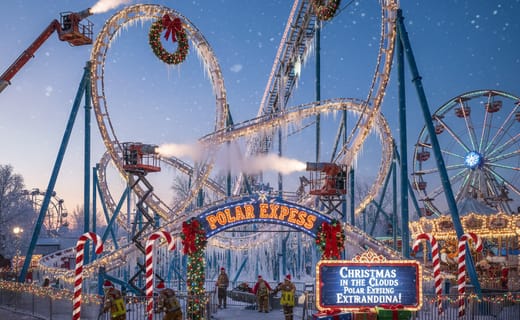Rollback: The Spectacular Phenomenon of Roller Coasters (All about Safety)
Published on 03/08/2025 by Julien
Updated on 03/08/2025 by Julien
Roller coasters are designed to give us thrills, adrenaline rushes, and unforgettable moments. But there's an event that, for thrill-seekers, is considered the ultimate Grail: the rollback. Far from being a dangerous malfunction, a rollback is actually a rare, spectacular phenomenon and, above all, proof of the robustness of an attraction's safety systems. This article invites you to delve behind the scenes of this mythical moment to understand what a rollback is, why it happens, and why you should hope for one on your next visit.
What is a Rollback?
A rollback occurs when a roller coaster train doesn't have enough kinetic energy to clear a major element of the track, such as a large hill (a "top hat") or an inversion. Under the effect of gravity, the train stops at the top of the incline and rolls backward down the same path.
For the average person, the sight of a train rolling backward down a steep incline might be a cause for concern. However, it's essential to understand that a rollback is not a technical failure. It is an operational event anticipated by engineers from the very design of the attraction. The track is specially designed to allow the train to return safely backward to the launch station, where magnetic or friction brakes will slow and stop it. This is one of the many integrated safety systems that ensure the attraction operates without risk, even under sub-optimal conditions.
This phenomenon is a matter of simple physics. The train is launched with a calculated amount of energy to allow it to clear key elements. If, for some reason, it lacks even a tiny amount of energy, a rollback is the natural and safe result. It's a perfectly choreographed dance between gravity and the train's energy.
Rollbacks on Launched Roller Coasters
While rollbacks are rare across all roller coasters, they are by far most frequent on launched coasters. These attractions are characterized by a very high-speed launch that propels the train directly onto a major element, often without the slow, gradual ascent of a traditional lift hill.
Propulsion can occur in several ways, such as through linear synchronous motors (LSM) or hydraulic systems. These launches are extremely powerful, but their intensity can be influenced by external factors. Weather conditions, such as headwinds, rain, or cold, can slightly reduce the train's speed. Additional weight due to a large number of heavier passengers can also alter the ride's dynamics. If any of these factors is sufficient to prevent the train from reaching the top, a rollback occurs.
The "top hat" is the element most often associated with rollbacks. It is a gigantic hill that goes up and down vertically. If the train does not have the necessary speed to clear the crest, it can only partially ascend before rolling back down under the force of gravity. The train then performs its spectacular backward journey along the launch track, where it is caught and stopped by a braking system. It will then be relaunched or returned to the station, proving that the attraction is designed to handle this event safely.
Possibility on Chain-Lift Roller Coasters
The probability of a rollback on a chain-lift roller coaster is extremely low. This is because these attractions use a fundamental safety mechanism that makes the phenomenon almost impossible: anti-rollback dogs.
These anti-rollback dogs are small metallic paws, securely fixed beneath the train, that lock onto the metallic teeth of the chain pulling it. This system is responsible for the characteristic clicking sound heard as a train ascends the lift hill. If, for some improbable reason, the lift chain were to break or the train lost its ability to be pulled upward, the anti-rollback dogs would immediately engage with the chain's teeth and prevent the train from rolling backward. The train would then be safely immobilized on the incline until technicians could intervene.
A rollback on a chain-lift roller coaster would only occur if a major and improbable malfunction of multiple anti-rollback dogs happened simultaneously, a scenario that is largely rendered impossible by industry safety standards. This is why, on these types of coasters, a rollback is not an expected event, but an emergency situation that safety systems are designed to actively prevent.
The Crucial Role of Mid-Course Brakes
In addition to the safety systems specific to different types of roller coasters, an essential mechanism ensures that no collision between trains can occur: mid-course brake runs. These sections of track, equipped with magnetic or friction brakes, are designed to slow or stop a train if necessary. They divide the track into several sections, called blocks.
The primary role of this block system is to allow multiple trains to operate on the circuit simultaneously while maintaining an absolute safe distance between them. A train cannot leave one section (a block) to enter the next unless the latter is empty. If the system detects that a block is still occupied, the mid-course brakes automatically engage to stop the preceding train and prevent it from moving forward.
This technology is the ultimate guarantee that even if a train stopped due to a rollback or any other unforeseen event, the next train would be stopped long before it could reach it. Engineers design tracks by ensuring that the distance between each block is sufficient to accommodate mid-course brakes, thus making collisions physically impossible. This is a fundamental safety feature that governs the operation of almost all modern roller coasters.
Safety to Avoid Accidents in Case of Rollback
Modern roller coaster engineering is first and foremost a discipline of safety. Designers and manufacturers dedicate thousands of hours to ensuring that every possible scenario, including a rollback, is accounted for and managed by infallible safety systems.
On launched roller coasters, multiple layers of safety are in place. The track layout is designed to allow the train to safely return without hitting anything. Sensors instantly detect if the train has not cleared an element and alert the control system. Brakes located on the launch track are immediately activated to slow the train in a controlled manner and bring it to a gentle stop. The train is then returned to the station pending operators either relaunching it or disembarking passengers. The train's design itself is optimized to remain stable and secure even when rolling backward.
On chain-lift roller coasters, safety is guaranteed by the redundancy of anti-rollback systems. Not only are there anti-rollback dogs on each car, but there are also emergency braking mechanisms on the track if needed. Automated monitoring systems continuously inspect the status of the chain and anti-rollback dogs, ensuring they function as intended. An accident due to a rollback on this type of coaster would be the result of a series of multiple failures, which is extremely unlikely.
The Most Famous Rollbacks
Some rollbacks have become legends in the world of roller coasters. The most famous ones have occurred on iconic attractions known for their extreme speed and height.
Top Thrill Dragster at Cedar Point, USA, is probably the most famous coaster for its rollbacks. With its 128-meter "top hat," the ride is a phenomenal acceleration skyward. Rollbacks are a regular occurrence on this attraction and are anticipated by fans as a spectacular bonus. Similarly, its counterpart, Kingda Ka at Six Flags Great Adventure, is also renowned for its rollbacks, enhancing their aura of mystery and luck for passengers. Other coasters, like Do-Dodonpa in Japan (known for its blistering acceleration) or Formula Rossa at Ferrari World (the world's fastest coaster), have also experienced rollbacks, only adding to their legend.
These examples of rollbacks on world-renowned attractions prove that this phenomenon is not synonymous with danger, but rather a fascinating facet of the physics and engineering behind these incredible machines.
The Rollback, a Rare and Harmless Bonus
If you are lucky enough to experience a rollback on a roller coaster, consider yourself privileged. Far from being a sign of danger, it is an impressive demonstration of the precision of attraction engineering and the effectiveness of its safety systems. It is a rare event that happens on exceptional coasters and a unique opportunity to see a facet of the ride that very few people get to experience.
It's a story to tell, an extra adrenaline rush, and proof that you defied gravity twice in a row. So, on your next visit to an amusement park, don't fear the rollback. On the contrary, hope for it. It is harmless, rare, and will transform your simple ride into an adventure you will never forget.
Share this blog post!
Liking this post?
Rate by setting a star level.







